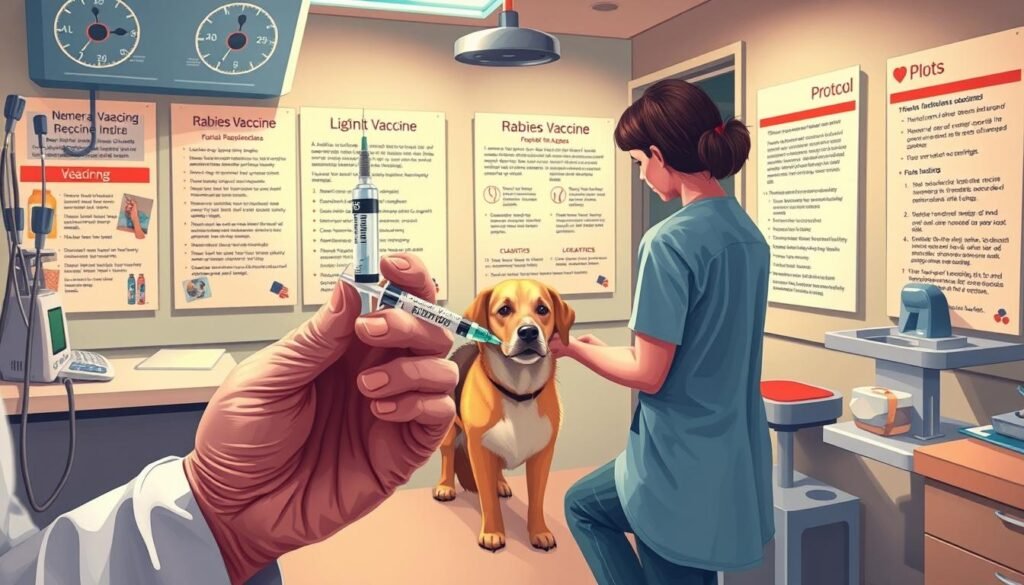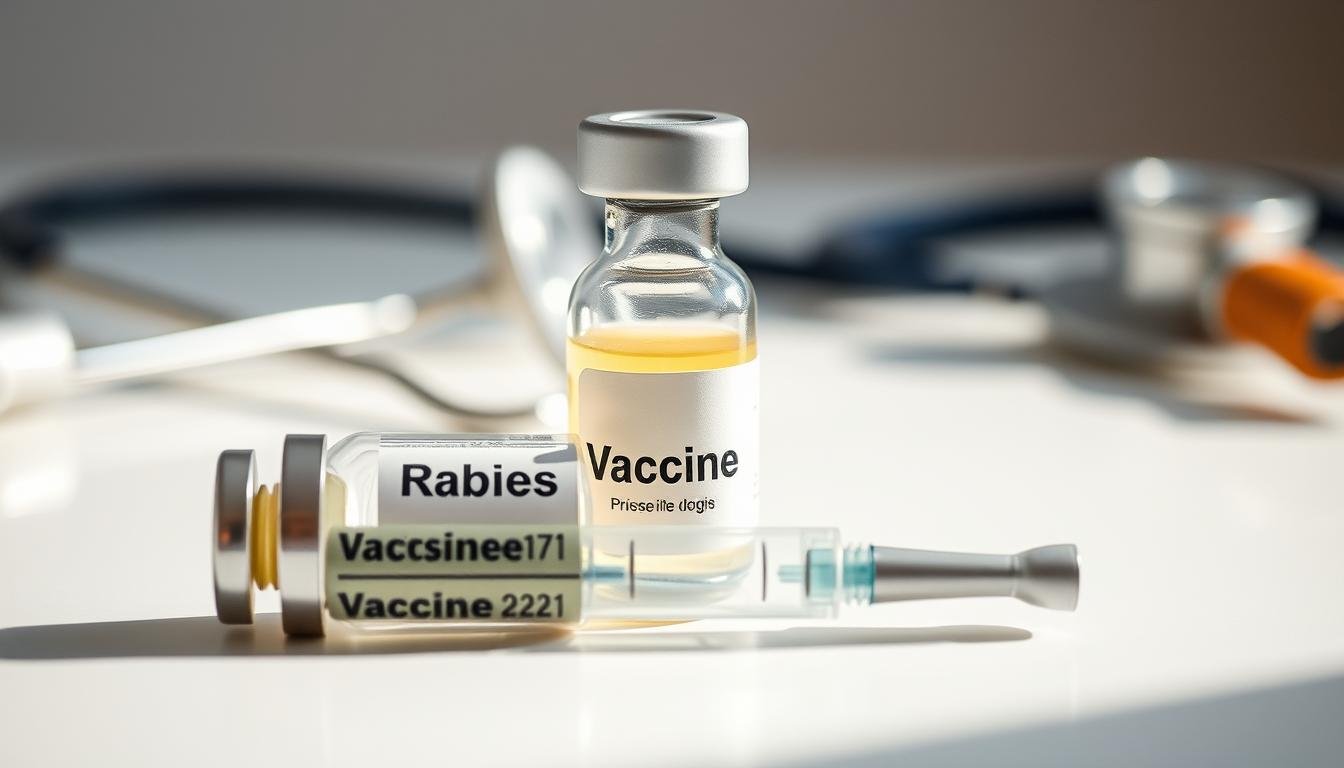When Sarah adopted her first puppy, Max, she was thrilled but overwhelmed. One question kept popping up: What’s the deal with rabies shots? Her vet explained that keeping Max protected wasn’t just about his health—it was a legal requirement and a critical step in safeguarding public health.
Rabies is a deadly disease that affects both animals and humans. Vaccinating your dog is not just a responsibility; it’s a necessity. In most states, the law mandates that pets receive their initial vaccine and follow-up boosters on a specific schedule. Missing these appointments can lead to serious consequences, including fines or even quarantine.
Whether you’re a new pet owner or a seasoned one, understanding the importance of timely vaccinations is crucial. This article, backed by expert vet advice, will guide you through the process, ensuring your furry friend stays safe and compliant with state regulations.
Key Takeaways
- Rabies vaccinations are legally required for dogs in most states.
- Initial puppy shots are critical, followed by regular boosters.
- Vaccination schedules vary based on the type of vaccine used.
- Keeping your dog vaccinated protects both pets and public health.
- Consult your vet to ensure compliance with local regulations.
Introduction to Dog Vaccinations and Rabies Importance
Protecting your pet starts with understanding their vaccination needs. Vaccines are divided into two categories: core and non-core. Core vaccines, like those for canine distemper and parvovirus, are essential for all dogs. Non-core vaccines, such as Bordetella, are recommended based on lifestyle and risk factors.
Core vaccines protect against severe and widespread diseases. Non-core vaccines address specific risks, like kennel cough or Lyme disease. Together, they form a comprehensive shield for your pet’s health.
Overview of Core and Non-core Vaccines
Core vaccines are mandatory for all dogs, regardless of their environment. They include protection against rabies, distemper, parvovirus, and adenovirus. These vaccinations are crucial for preventing life-threatening illnesses.
Non-core vaccines are tailored to individual needs. For example, dogs that frequent boarding facilities may benefit from the Bordetella vaccine. Consulting your vet helps determine which non-core vaccines are necessary for your pet.
Why Rabies is Critical for Public Health
Rabies is a deadly disease that affects both animals and humans. Vaccinating your dog not only protects them but also safeguards public health. According to the CDC, routine vaccinations have significantly reduced rabies cases in domestic animals.
Dr. Kathy Wentworth, a renowned veterinarian, emphasizes that rabies prevention is a shared responsibility. “Vaccinating your dog is a simple yet powerful way to protect your family and community,” she says.
In the U.S., rabies cases in dogs have dropped dramatically thanks to widespread vaccination efforts. This highlights the importance of adhering to vaccination schedules and local regulations.
How Often Do Dogs Need Rabies Shots: A Closer Look
Rabies vaccination schedules are designed to ensure long-term protection for your pet. The timing of these boosters is critical to maintaining immunity and complying with local laws. Understanding the differences between one-year and three-year vaccines can help you make informed decisions.
Understanding Vaccine Duration and Booster Timelines
Rabies vaccines provide immunity for a specific period, typically one to three years. The initial booster is administered one year after the first dose. After that, the frequency depends on the vaccine type and state regulations.
Scientific studies show that some vaccines offer protection for up to three years. However, certain states mandate annual boosters regardless of the vaccine’s labeling. Always consult your vet to determine the best schedule for your pet.
State Requirements vs. Vaccine Labeling
State laws often dictate the frequency of rabies boosters, which may differ from the vaccine manufacturer’s recommendations. For example, a three-year vaccine might still require annual boosters in some areas.
Dr. Emily Carter, a veterinary expert, explains, “Adhering to state laws is non-negotiable. Even if a vaccine is labeled for three years, local regulations may override this.”
To avoid confusion, keep track of the date of your pet’s last booster shot and check your state’s specific requirements. This ensures your pet remains protected and compliant.
Strict adherence to a consistent schedule is essential for ongoing protection. Missing a booster by even a few weeks can compromise your pet’s immunity. Stay proactive and mark your calendar to stay on track.
Rabies Vaccine Protocols: Guidelines and State Laws

State laws play a critical role in determining rabie vaccine schedules. These regulations ensure that pets are protected and public health is safeguarded. Compliance is not optional—it’s a legal requirement.
Each state has specific guidelines for rabie vaccination. For example, Florida mandates that all dogs, cats, and ferrets receive their first dose by four months of age. Failure to comply can result in fines or even quarantine.
Legal Implications of Non-compliance
Ignoring rabie vaccine protocols can have serious consequences. In many states, unvaccinated pets that bite a human must undergo a 10-day quarantine. This can be stressful for both the pet and the owner.
Dr. Lisa Harper, a licensed veterinarian, explains, “Non-compliance isn’t just a legal issue—it’s a public health risk. Rabies is fatal, and vaccination is the only effective prevention.”
In some cases, owners may face legal action if their unvaccinated pet causes harm. For instance, in California, a dog owner was fined $1,000 for failing to vaccinate their pet, which later bit a neighbor.
Role of Veterinarians in Ensuring Compliance
Veterinarians play a key role in administering the correct rabie vaccine based on the pet’s age and state requirements. They also educate owners about the importance of timely boosters.
Choosing the right type of vaccine is equally important. Some vaccines offer protection for one year, while others last up to three years. Your veterinarian can help you decide which option is best for your pet.
| State | Minimum Age for Vaccination | Booster Frequency |
|---|---|---|
| Florida | 4 months | 1-3 years |
| California | 4 months | Every 2 years |
| Texas | 3 months | 1-3 years |
| New York | 3 months | 1-3 years |
Adhering to state law and working closely with your veterinarian ensures your pet remains protected. This not only keeps your furry friend safe but also contributes to a healthier community.
Managing Vaccine Side Effects and Booster Tips

After your pet receives a rabies vaccine, it’s natural to monitor for any changes in behavior or health. While most pets handle vaccinations well, some may experience mild side effects. Knowing what to expect can help you ensure your furry friend stays comfortable and safe.
Common Side Effects to Watch For
Mild reactions are common and usually resolve within a day or two. These include swelling or tenderness at the injection site, slight fever, and reduced appetite. Your pet may also seem more tired than usual.
In rare cases, more serious side effects can occur. Symptoms like vomiting, diarrhea, or difficulty breathing may indicate an allergic reaction. If you notice these signs, contact your veterinarian immediately.
When to Seek Veterinary Advice
While most reactions are minor, some require prompt attention. Persistent swelling, high fever, or difficulty moving are red flags. Dr. Jane Miller, a veterinary expert, advises, “If your pet shows severe symptoms, don’t wait—seek professional help right away.”
Monitoring the injection site is also important. A small lump is normal, but if it grows or doesn’t fade, consult your vet. They can assess whether further treatment is needed.
Here’s a quick guide to help you differentiate between normal and concerning reactions:
- Normal: Mild swelling, slight fever, temporary lethargy.
- Concerning: Difficulty breathing, persistent vomiting, severe swelling.
By staying vigilant and informed, you can ensure your pet’s vaccination experience is as smooth as possible. Always keep your vet’s contact information handy for peace of mind.
Additional Considerations for Your Dog’s Vaccination Schedule
Ensuring your pet’s health starts with a clear vaccination plan. From puppies to adult dogs, each stage of life requires specific attention to maintain protection against diseases. Understanding these timelines helps you stay proactive and keep your furry friend safe.
Puppy Vaccination Timeline and Initial Immunity
Puppies need a series of shots to build immunity. The initial series typically begins at 6-8 weeks and continues every 2-4 weeks until they are 16-20 weeks old. Core vaccines like distemper, parvovirus, and adenovirus are administered during this period.
Early vaccinations are crucial for prevention. Puppies are vulnerable to diseases, and timely shots provide the necessary protection. Missing a dose can increase the risk of illness, so stick to the schedule recommended by your vet.
Adult Dog Booster Recommendations and Maintenance
Adult dogs require regular boosters to maintain immunity. Core vaccines like rabies and distemper are often given every year or every three years, depending on the vaccine type and state regulations. Non-core vaccines, such as Bordetella, may be needed based on lifestyle.
Delaying boosters can compromise your pet’s protection. If a booster is missed, consult your vet immediately to minimize the risk. Staying on schedule ensures your animal remains healthy and compliant with local laws.
Here’s a quick checklist to help you stay on track:
- Puppies: Start vaccinations at 6-8 weeks and follow the vet’s schedule.
- Adults: Administer boosters every year or as recommended.
- Monitor for side effects and seek veterinary advice if needed.
Taking action today ensures your pet’s long-term health. A well-maintained vaccination schedule is the best way to protect your furry friend and contribute to a healthier community.
Conclusion
Keeping your pet safe from the rabies virus is a responsibility every owner must prioritize. This always fatal disease poses a significant threat to both animals and people. Timely rabies vaccine boosters are essential to maintain immunity and comply with state laws. Missing even a single dose can leave your pet vulnerable.
Monitoring for symptoms post-vaccination is crucial. Check the injection site for any unusual reactions. If you notice persistent swelling or behavioral changes, consult your veterinarian immediately. Staying informed about local regulations ensures your pet remains protected and compliant.
Research shows that vaccinated pets can maintain immunity for extended periods, supporting the potential for longer intervals between rabies vaccinations. However, always follow your vet’s advice to ensure ongoing protection.
Protecting your pet from the rabies virus safeguards not only their health but also public safety. Take action today—consult your veterinarian and stay proactive about your pet’s vaccination schedule.





Seems like rabies shots are more about public safety than dog health. Thoughts? Are we over-vaccinating our pets for human benefit?
Isnt it better to over-vaccinate our pets against rabies, given the risk to public health? Curious to know expert views.